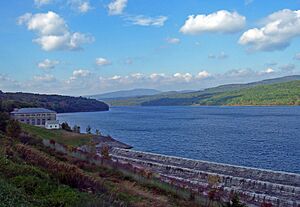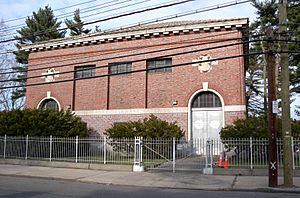Delaware Aqueduct facts for kids
<mapframe text="Delaware Aqueduct, New York" width="300" height="300"> { "type": "ExternalData", "service": "geoline", "ids": "Q2859238", "properties": { "title": "Delaware Aqueduct, New York", "description": "Delaware Aqueduct in New York", "stroke": "#0000ff", "stroke-width": 8 } } </mapframe>

The Delaware Aqueduct is a huge underground tunnel that carries water for New York City. It is part of the city's important water supply system. This aqueduct brings water from several large reservoirs west of the Hudson River. These include the Rondout Reservoir, Cannonsville Reservoir, Neversink Reservoir, and Pepacton Reservoir.
The water travels through the Chelsea Pump Station. Then, it goes to reservoirs east of the Hudson River. These are the West Branch Reservoir, Kensico Reservoir, and Hillview Reservoir. The journey ends at Hillview in Yonkers, New York.
Workers built the Delaware Aqueduct between 1939 and 1945. It supplies about half of New York City's daily water, which is about 1 billion US gallons (3.8 million cubic meters). This amazing tunnel is 13.5 feet (4.1 meters) wide and 85 miles (137 kilometers) long. It is known as the world's longest tunnel.
Contents
Where Does New York City's Water Come From?

The Delaware Aqueduct collects water from a large area called a watershed. This watershed covers 95 square miles (246 square kilometers). It holds about 49.6 billion US gallons (188 million cubic meters) of water. The water comes from the Rondout, Cannonsville, Neversink, and Pepacton reservoirs.
The Cannonsville, Neversink, and Pepacton reservoirs are all part of the Delaware River watershed. The Rondout Reservoir also collects water for this system. However, the Rondout Creek, which feeds it, is part of the Hudson River watershed.
Together, these four reservoirs gather water from a huge area of 1,012 square miles (2,621 square kilometers). They can hold a total of 320.4 billion US gallons (1.2 trillion liters) of water. About 890 million US gallons (3.4 million cubic meters) of this water goes to New York City every day. This amount meets about half of the city's daily water needs.
All this water flows from the Rondout Reservoir to the West Branch Reservoir in Putnam County, New York. From there, it travels to the Kensico and Hillview reservoirs in southern Westchester County, New York. Finally, it reaches New York City for people to use.
Fixing Leaks in the Aqueduct
In 1988, engineers found leaks in the Delaware Aqueduct. A lot of water, up to 36 million US gallons (136,000 cubic meters) each day, was escaping. New York City officials spent many years studying the problem. They worked to find the best way to fix these leaks.
How the Leaks Were Repaired
The New York City Department of Environmental Protection (NYCDEP) built a special bypass tunnel. This tunnel is called the Rondout-West Branch Bypass Tunnel. It is 2.5 miles (4 kilometers) long and goes deep under the Hudson River. This new tunnel allows water to go around the leaky parts of the old aqueduct.
Construction on this big project started in November 2013. The total cost for the repairs was about $1.5 billion. About $1 billion of that went into building the bypass tunnel. This tunnel was built around the biggest leak in Roseton. Workers also did extra concrete work in the Wawarsing area to stop other leaks.
The new bypass tunnel was the largest construction project in NYCDEP's history. Workers finished digging the tunnel, which is 500 feet (152 meters) under the Hudson River, in 2019. The project involved digging two deep shafts, one 700 feet (213 meters) and another 900 feet (274 meters) deep.
To complete the final repairs, a section of the aqueduct needed to be temporarily shut down. This shutdown happened in September 2024 for the northern part of the tunnel. The repair work was paused in November 2024 because of dry weather conditions. As of mid-2025, the NYCDEP expects the final stage of the repair project to be finished in 2027.
Other Important Water Systems
- Catskill Aqueduct
- Croton Aqueduct
- Delaware River Basin Commission

